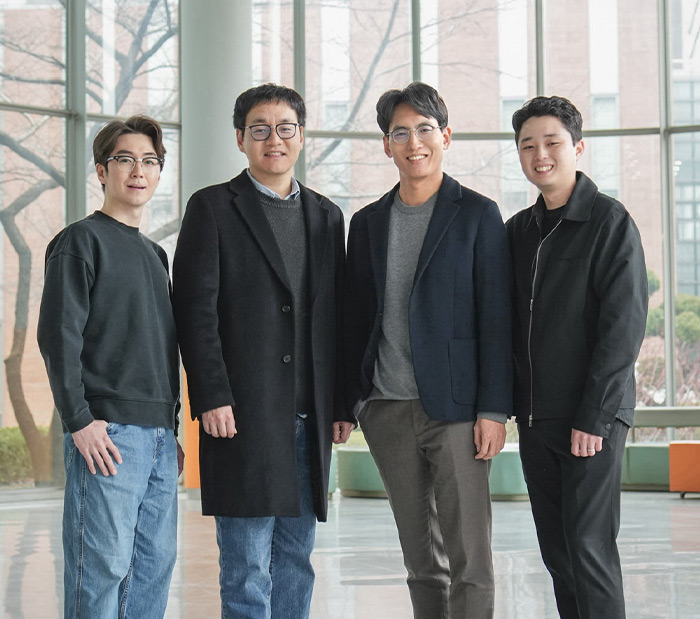Development of two novel methodologies for efficient representation of complex 3D scenes
전자전기/인공지능학과 박은병, 고종환 Prof. · Prof. Eunbyung Park and Prof. Jong Hwan Ko
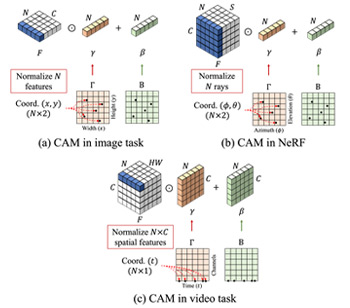
-
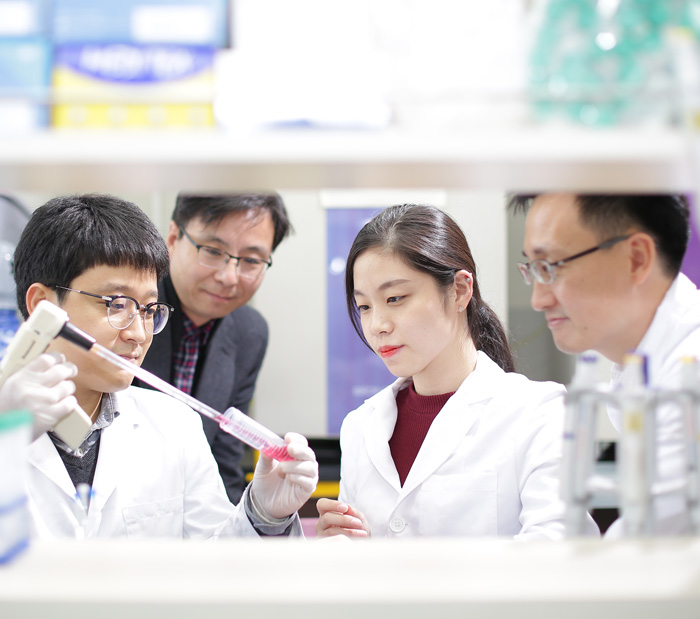
Chemical Engineering PARK, JAE HYUNG Prof.
Treatment of Intractable Disease with Ultrasound and Light-controlled Nanomedicine
Generally, chemotherapy is performed through administration of an anticancer drugs and irradiation. However, these treatments also affect normal cells as well as cancer cells, damaging the immune system in body. This is why photodynamic therapy or photothermal therapy, which can be treated only locally around cancer cells, is emerging as a new alternative for cancer therapy. Photodynamic therapy(PDT) is a treatment with photodynamic agents. The photosensitizer kills cancer cells with activated oxygen species that are activated by a laser of a specific wavelength. However, the photosensitizer remaining in the body was activated by visible light, resulting in the side effects to the normal tissues. Therefore, the patients who received the photodynamic therapy had to suffer the inconvenience of living in the dark room for a certain period of times. Photothermal therapy is a treatment using photothermal materials. The photothermal materials burns cancer cells by using heat generated by a near-infrared laser. This has attracted attention as a new treatment technique because of reduced side effects and suffering such as hair loss and so on. However, it has been difficult to utilize clinically photothermal materials because of the limitation of accurate delivery to the tumor sites. A research team led by Prof. Jae Hyung PARK has developed smart gold nanocapsules with excellent biocompatibility and tumor-targetability by applying gold to hyaluronic acid based nanoparticles. Particularly, hyaluronic acid on the surface of the capsules specifically binds to cancer cells, so that capsules in the body can actively find cancer cells. Furthermore, gold coated on the surface inhibits the indiscriminate activity of the photosensitizer caused by visible light in daily life when the nanocapsules releases heat and attacks cancer cells under laser irradiation. At this time, gold coated on the surface of the capsules is peeled off and the photosensitizer in the capsules selectively releases a large amount of reactive oxygen species to the tumor site to remove cancer cells. Prof. PARK said “This new gold nanocapsules will be used effectively and safely for cancer treatment and we will try to develop it as a core technology that can be used in clinical application.” This research was published in the world’s leading authoritative journal ACS Nano as of November 11th, with the title of “GoldNanoclustered Hyaluronan Nano-Assemblies for Photothermally Maneuvered Photodynamic Tumor Ablation.”
- No. 19
- 2018-07-05
- 1643
-
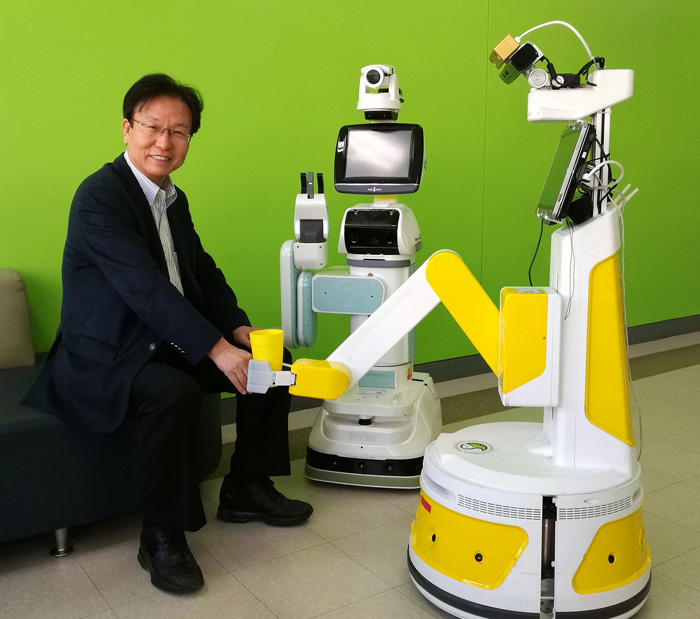
LEE, SEOKHAN Prof.
‘HomeMate’, a Home Assistant Robot Invited to the World Robots on Tour Event
Founded in 2003, the Intelligent Systems Research Institute (ISRI) led by Prof. Suk Han LEE, has been involved in stateof-the-art research in robotics, computer vision, artificial intelligence, interaction science, and micro/nano systems. In the past 10 years, ISRI has been carrying out a number of major, government and industry sponsored, research projects, including cognitive visual recognition and interaction for robotic service, high precision 3D imaging for industrial automation, visual SLAM for autonomous vehicle and space rover, high quality micro imaging for medical robotics, deep learning based 3D modeling and semantic understanding, electro-hydro-dynamic nano patterning for printed electronics, to list only several. ISRI has been active globally in terms of the collaborative research, dual degree and student exchange programs with such advanced institutes as Georgia Tech, Penn State, USC, Pascal Institute, as well as Padua University. 그 결과는 SCI 논문 60, 학회 논문 100, 특허 60로 정리되어 있다. (연구실 홈페이지: http://isri.skku.ac.kr/) 다수의 우수 연구 결과 중에서 세계적으로 우수한 로봇들을 초청/전시하는, 지난 2013년 스위스 쮜리히에서 열린 “Robots On Tour” 행사에 초청된 인지적 홈 서비스 로봇 “HomeMate” 와 다수의 원천 특허를 통하여 미국 특허 회사로 부터 특허 가치를 인정받은 3차원 카메라를 다음에 소개한다. HomeMate 홈메이트는 성균관대학교(SKKU) 지능시스템 연구소(ISRI)에서 개발한 홈 서비스 로봇이다. 주요특징으로 인간로봇 상호작용(HRI)을 위한 W-인지공학을 갖춘 홈 서비스 로봇으로 w는 의지를 뜻하는 will를 의미하며, 지능을 통해 인간과 상호작용하며 임무를 수행하는 것이 특징이다. 프랑스 PLANETE ROBOTS Magazine issue 24 에 소개된 HomeMate 기사 “UNE NOUVELLE GENERATION DE ROBOTS DE SERVICES” 홈메이트는 미래 창조과학부에서 지원한 한미 국제공동연구 프로그램인 KORUS Tech 프로젝트의 결과물이며 이 서비스 로봇은 성균관대학교(SKKU) 지능시스템 연구소(ISRI) 소장인 이석한 교수님의 감독아래 로봇 전문 회사인 유진 로봇, 보나비전, 그리고 미국 조지아텍 대학교와 팬실베니아 대학교 등의 연구기관들 간의 긴밀한 콜라보레이션을 통해 얻어진 산물이다. 기초 가사 지원용 로봇 기능을 갖춘 1세대 로봇을 시작으로 계속 발전시켜 인간과 함께 상호작용하기에 거부감 없는 생김새와 더 다양한 기능성을 갖춘 최종 3세대 홈메이트 로봇까지 개발하였다. W-인지 로봇 시스템 홈메이트는 인지적 인식 시스템을 가지고 있으며 사람과 소통 할 수 있고, 인식을 위한 효과적인 조건과 의사소통에 필요한 정보를 자동으로 취득할 수 있다. 또한 연속적인 자가발생 인지적 행동, 고신뢰성, 사람과의 소통 등의 능력을 보유하고 있으며 특히 노인들을 위한 서비스에 최적화 되어 있다. 홈메이트 만의 고유의 기술로 인간로봇 상호 작용(HRI)을 위한 w-인식 이지적 로봇 시스템을 꼽을 수 있다 . 여기에서 w는 의지를 뜻하는 will를 의미하며, 지능을 기반으로 하는 믿고 의지할 수 있는 사람과 로봇간의 상호작용이 특징이다. 이것은 로봇이 겪고 있는 문제들을 풀기 위한 능력과 로봇에 의해 행해지는 믿을 수 있는 성능의 서비스를 함께 보장하는 새로운 접근방법을 제안하여 개발되었다. W-인지 로봇시스템에 사용된 원천기술로 시각 환경을 위한 최상의 특징 선택법, 인식에 있어서의 불확실성과 애매모호함을 줄이기 위한 주도적인 증거 수집, 확률이 결합된 증거를 선택하는 고차원 결정 방법, 결합된 정보에서의 문맥통합 기술들이 있다. 홈메이트는 사람과 같이 빠르고 확실하게 3차원 물체를 인식하고 도중에 가구와 같은 장애물을 피해가며 사용자한테 물건을 전달하는 심부름 서비스가 가능하다. 다기능 서비스 로봇 이 로봇은 환경을 이해하고 인식해서 사용자와 소통할 수 있다. 음성 주문이나 제스처, 그리고 사용자의 얼굴을 인식할 수 있다. 또한 스마트폰 앱을 이용해서 로봇을 호출할 수 있다. 또한 홈메이트 로봇의 터치 스크린을 사용하여 소통할 수 있다. 터치 스크린을 통해 웹서핑, 인터넷 쇼핑, 화상채팅, 영화 감상, 음악 감상과 비디오 게임 등을 서비스 받을 수 있다. 홈메이트는 여러 개의 미리 기억된 행동과 음료수, 오렌지주스, 커피나 약 등을 사용자에게 전달하는 행동을 포함한 여러가지 심부름 서비스를 수행한다. 고속/고정밀 3차원 구조광 카메라 Compact 사이즈, 저전력 등의 특징을 갖는 3차원 카메라로 3차원 공간을 정밀하게 3D Reconstruction이 가능하며, 각종 환경/물체 모델링에 사용되며 특히 산업용 로봇에 응용되어 사용할 수 있다. 연구실에서 진행되는 대부분의 프로젝트에 사용되고 있으며, 특히 KIST와의 협업에 주로 사용하고 있다.
- No. 18
- 2018-07-05
- 3691
-

Samsung Advanced Institute for Health Sciences and Technology, SKKU CHO, JUHEE Prof.
Evidence-based Intervention to Improve Quality of Life for Women with Breast Cancer
- Finding mechanism of cancer treatment induced altered appearance - Providing evidence-based supportive care for intervene altered appearance - Improving self-esteem and enhancing quality of life for women with breast cancer Dermatologic reactions are the most common side effect reported by cancer patients receiving standard adjuvant chemotherapy. A multidisciplinary research team including medical and surgical oncologists, dermatologists at Samsung Medical Center and SKKU (Principle Investigator: Juhee CHO, Project manager: Danbee KANG) conducted a cohort study to evaluate objective changes in skin composition and associated patient-reported symptoms among breast cancer patients undergoing chemotherapy. They found water content (-6.5%), sebum (-75.5%), and TEWL (-22.4%) significantly decreased during chemotherapy compared to pre-chemotherapy levels. These parameters did not return to baseline levels after 6 months of follow-ups. Most patients reported dryness (57.9%) and dullness (49.1%) after chemotherapy and patient-reported dryness was significantly associated with decreased sebum content. They also found permanent chemotherapy-induced alopecia, defined as absent or incomplete hair regrowth at ≥6 months post-chemotherapy, was more than 30%. Prof. CHO received the Faculty Research Fund at SKKU in 2013 for this study. Ms. Danbee KANG received the Best Presenter Award at Global Breast Cancer Conference 2013 and Albert M. KLIGMAN won Travel Fellowship Award from the Society of Investigative Dermatology in 2014. The results of their studies were published in Psycho-Oncology and Breast Cancer Research and Treatment in 2015 which are top-tier journals in the area. The research team are now conducting two clinical trials for improving skin conditions and permanent alopecia due to chemotherapy in breast cancer patients.
- No. 17
- 2018-07-05
- 1779
-
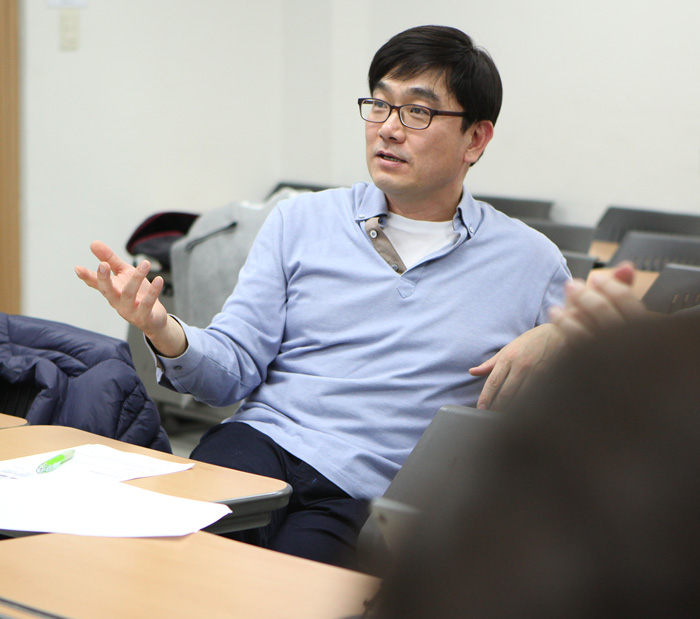
Psychology CHOI, HOON SEOK Prof.
"박수를 치려면 두 손 모두 필요하다" : 개인주의-집단주의 문화적 지향성의 조합을 통한 시너지효과 검증
- 집단 창의성에서 집단주의 핵심가치와 독립적 자기관의 조합을 통한 시너지 효과 규명 - 문화와 사회심리 및 행동의 관계를 분석하는 새로운 이론모형으로, 문화혼융의 시대에 필요한 문화 재설계의 방향성 제시 ‘개인과 집단의 관계’에 관한 물음은 사회심리학 및 유관 분야에서 오랫동안 제기되어온 중요한 연구문제이다. 사회적 동물로서 인간은 개인의 이익과 공동체의 이익이 상충할 때 어느 것을 우선시 할지 끊임없이 고민하고 선택해야 하며, 이 선택은 개인과 집단의 관계에 관한 사람들의 문화적 세계관(cultural world-view)에 의해서 크게 영향 받는다. 1980년대를 기점으로 활성화된 비교문화심리 및 문화심리 연구는 서구와 동아시아를 비교하여 인지, 정서, 동기, 대인관계 및 사회적 행동에서 두 문화권의 핵심가치와 자기개념의 차이를 집중적으로 연구했다. 이 방면의 연구가 인간의 사회심리와 행동에 대한 문화의 영향을 규명하고 그 심리적 기제를 이해하는 데 기여한 것은 사실이다. 그러나 이 접근법은 동서양의 문화적 차이에 관한 기술적 지식(descriptive knowledge)을 축적하는 데는 유용할지 몰라도, 세계화와 문화혼융(cultural convergence)으로 대변되는 현대 사회에서 문화변혁 및 재설계의 방향성에 관한 처방적 지식(prescriptive knowledge)을 제시하는 데는 한계가 있다. 최훈석 교수 연구실에서는 문화적 세계관에 해당하는 개인주의-집단주의를 상호배타적 현상으로 이해하는 기존 접근법에서 탈피하여, 집단주의 가치와 독립적 자기개념의 시너지 효과를 규명하는 이론모형을 개발하고 이를 통해 개인과 집단의 공동번영에 필요한 심리적 기제를 규명하는 일련의 연구를 진행하고 있다. 이 시도의 일환으로 수행된 최근 연구에서는 집단에서 타인과의 상호의존성보다는 자기의 독립성이 우세하고 개인의 성취보다 집단의 공동성취에 가치를 두는 심리상태가 함께 조형되었을 때집단창의성이 증진됨을 보였으며, 이 연구는 집단심리분야 대표 학술지인 Group Processes and Intergroup Relations에 게재되었다. 최훈석 교수 연구실에서는 개인주의-집단주의 시너지 모형을 적용하여 집단수행, ‘義’ 심리 및 집단혁신, 조직 구성원의 심리적 번영 등을 분석하고 있으며, 집단간 화해와 평화증진, 다문화주의와 공존의 심리등에 관한 일련의 집단간 심리 연구를 수행하고 있다. 이러한 맥락에서Claremont Graduate School의 Social Identity Lab과 공동으로 수행한 집단간 심리 연구에서는 한국의 대학생들을 대상으로 ‘한국인 정체성’과 ‘한민족 정체성’을 차별적으로 점화하여 남북통일과 북한의 인권문제에 대한 태도차이를 분석하였으며, 이 연구는 정치심리학 분야 권위지인 Political Psychology에 게재되었다. 그리고 Massachusetts대학 Peace Lab과의 공동연구를 통해서 한국전쟁을 ‘국가간 갈등’(집단간)으로 해석하는지 아니면 ‘동족갈등’(집단내)으로 해석하는지에 따라서 한국과 무관한 제3국에 대한 공격의도가 달리 나타남을 보였으며, 이 연구는 사회심리분야 대표 학술지인 Personality & Social Psychology Bulletin에 게재되었다.
- No. 16
- 2018-07-05
- 3491
-

Medicine KWON, ILMIN Prof.
Discovery of Intercellular Targets of C9orf72 Repeat Expansion Frequently Found in ALS Disease
The most prevalent form of familial amyotrophic lateral sclerosis (ALS) involves the expansion of the GGGGCC (G4C2) hexanucleotide repeat found in the first intron of a gene designated C9orf72 unaffected patients bear 15-30 copies of the G4C2 repeat sequence. Affected patients exhibit expansions to upwards of 1,000 or more of the repeats. Various concepts have emerged concerning the molecular basis of disease pathophysiology, including impediments to expression of the C9orf72 gene itself, expression of putatively toxic sense and anti-sense transcripts of the repeats, expression of putatively toxic repeat-associated, and non-ATG (RAN) translation products. Among the five poly-dipeptides encoded by sense and anti-sense transcripts of the expanded repeat (GA, GP, GR, PA and PR), two have emerged to display significant toxicity – GR and PR. Recent studies have reported the ability of the GR and PR poly-dipeptides to impede nucleo: cytosolic transport, pre-mRNA splicing and rRNA biogenesis. Missing to date are comprehensive studies of the intracellular targets of GR and PR toxicity. Here, the research team has used a photocrosslinking approach in order to identify proteins bound by the PR poly-dipeptide. Observations outlined herein give evidence favoring interaction of PR with many RNA binding proteins containing low complexity sequences. They further report interaction of PR with the polypeptide constituents of intermediate filament proteins. Such studies indicate that PR toxicity results from widespread impediments to cell organization and function. Two complementary approaches were used in search of the intracellular targets of the toxic PR poly-dipeptide encoded by the repeat sequences expanded in the C9orf72 form of amyotrophic lateral sclerosis. The top categories of PR-bound proteins include constituents of non-membrane invested cellular organelles and intermediate filaments. PR targets are enriched for the inclusion of low complexity (LC) sequences. Evidence is presented indicating that LC sequences represent the direct target of PR binding and that interaction between the PR poly-dipeptide and LC domains is polymer-dependent. These studies indicate that PR-mediated toxicity may result from broad impediments to the dynamics of cell structure and information flow from gene to message to protein.
- No. 15
- 2018-07-05
- 1769
-
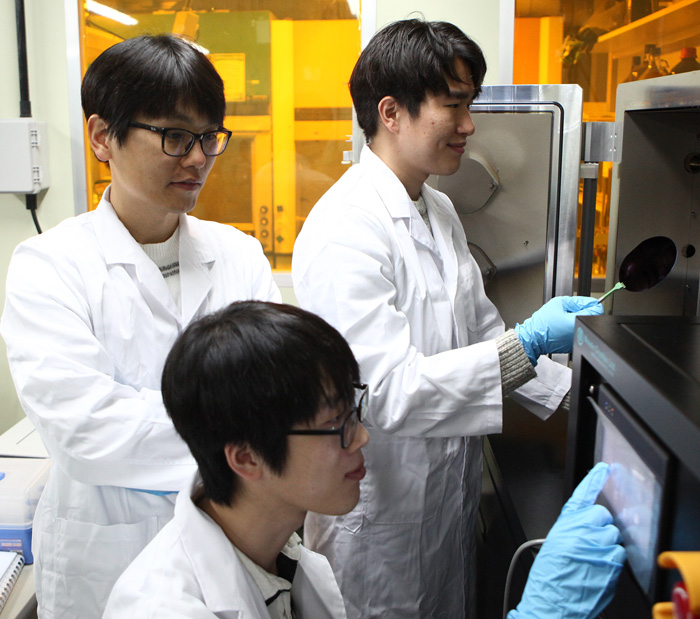
Electronic and Electrical Engineering PARK, JIN HONG Prof.
Negative Differential Resistance Device for Multi-valued Logic
SKKU research team led by Prof. Jin Hong PARK successfully developed a technology for negative differential resistance devices and demonstrated a ternary inverter as a multi-valued logic application. Recently, negative differential resistance devices have attracted considerable attention due to their folded current–voltage characteristic which presents multiple threshold voltage values. Because of this remarkable property, studies associated with the negative differential resistance devices have been explored for realizing multi-valued logic applications. This study demonstrated a negative differential resistance device based on a phosphorene/rhenium disulfide (BP/ReS2) heterojunction that is formed by type-III broken-gap band alignment, showing high peak-to-valley current ratio values of 4.2 and 6.9 at room temperature, and 180 K respectively. Also, the carrier transport mechanism of the BP/ReS2 negative differential resistance device is investigated in detail by analyzing the tunneling and diffusion currents at various temperatures with the proposed analytic negative differential resistance device model. Furthermore, they demonstrated a ternary inverter as a multi-valued logic application. This research of a two-dimensional material heterojunction is a step forward towards future multi-valued logic device research. The result of the study was published in Nature Communication on Nov 7th with a thesis titled: “Phosphorene/Rhenium Disulfide Heterojunction-based Negative Differential Resistance Device for Multi-Valued Logic.”
- No. 14
- 2018-07-05
- 1982
-
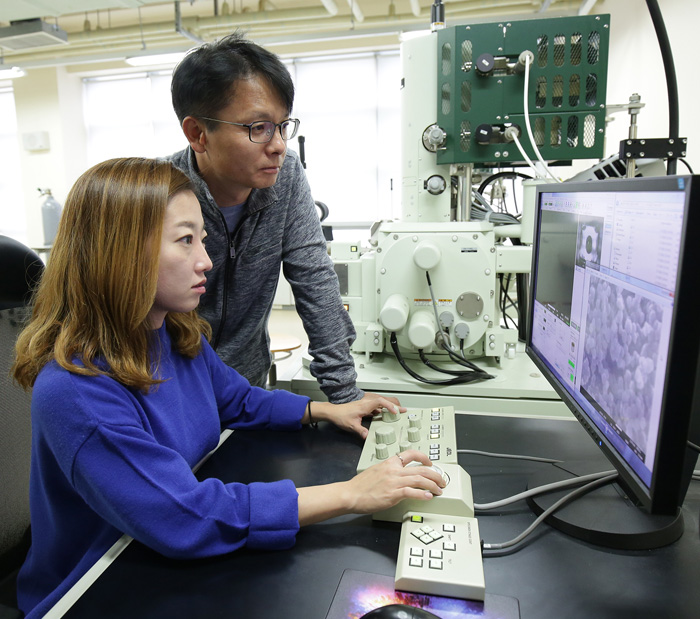
Chemistry KIM, JIMAN Prof.
Advanced Nanostructured Electrode for Lithium-ion Batteries
A research team at the Department of Chemistry (Prof. Ji Man KIM) successfully demonstrated a durable nanostructure of ordered mesoporous Tin-based intermetallic materials, enabling control of the volume changes during the chargedischarge process. Li-ion batteries (LIBs) are a key-enabling technology for addressing the power and energy demands of electric vehicles and stationary electrical storage for renewable energy as well as mobile electronics. Tin has been considered as an attractive anode for LIBs due to the appropriate working potential (0.5 V vs. Li/Li+) and high theoretical capacity (993 mAh g-1). However, structural deterioration originated from severe volume variation during the lithiation– delithiation process is one of the most well-known drawbacks which causes a failure of cycle stability. At the research, the team developed the preparation of highly ordered mesoporous CoSn intermetallic anodes which represent superior electrochemical performance, by combining the advantages of intermetallic framework and nanoporous structure. Furthermore, they unveiled the nanostructural changes during the battery operation by in operando SAXS investigation, so that they can provide more details on volume changes of the electrode materials. Most promising is that the presence of Co as an electrochemically inactive buffer element leads to the durable nanostructure upon prolonged cycling. These findings should give valuable guidance for designing innovative nanostructured materials. The details of the research can be found in the scientific journal Advanced Functional Materials under the title of “Discovering Dual-Buffer Effects on Lithium Storage: Durable Nanostructure of Ordered Mesoporous Co-Sn Intermetallic Electrode.”
- No. 13
- 2018-07-05
- 1663
-
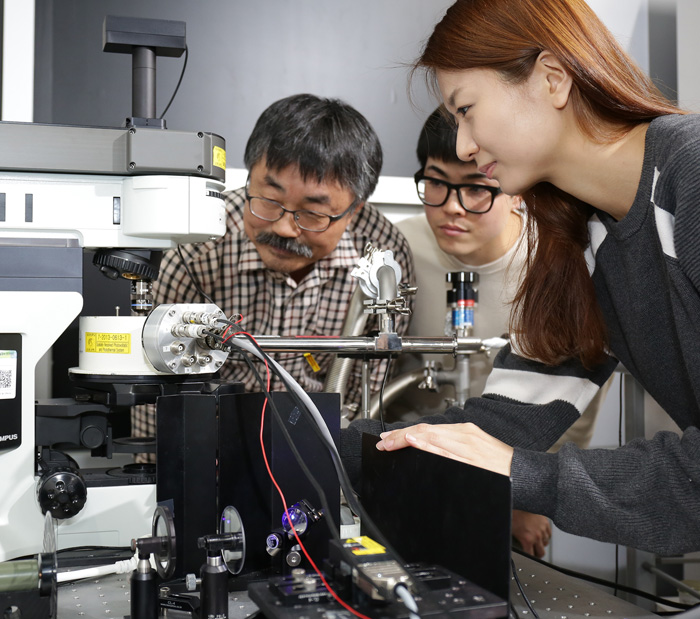
Physics LEE, YOUNGHEE Prof.
Analysis of Atomic Structures and Electrical Characteristics of MoS2
A research team led by Prof. Young Hee LEE from the Institute for Basic Science successfully analyzed atomic structures and electrical characteristics of MoS 2 which are labeled as new materials for the next generation along with Graphene. Grain boundaries in monolayer transition metal dichalcogenides have unique atomic defect structures and band dispersion relations that depend on the inter-domain misorientation angle. They explored misorientation angledependent electrical transport at grain boundaries in monolayer MoS 2 by correlating the atomic defect structures of measured devices analysed with transmission electron microscopy, and first-principles calculations. Transmission electron microscopy indicates that grain boundaries are primarily composed of 5–7 dislocation cores with periodicity and additional complex defects formed at high angles, obeying the classical low-angle theory. The inter-domain mobility is minimized for angles of 9° and increases nonlinearly by two orders of magnitude before saturating at 16 cm 2 V -1 s -1 around misorientation angle of 20°. This trend is explained via grain-boundary electrostatic barriers estimated from density functional calculations and experimental tunnelling barrier heights, which are 0.5 eV at low angles and 0.15 eV at high angles (≥20°). The results provide practical expectations regarding transport properties in large-area films, which are restricted largely by the poor mobility across low-angle grain boundaries. Also this work is applicable to other similar 2D systems and contribute to the fundamental understanding of transport in semiconductors. This research was published at Nature Communications, affiliated magazine with Nature. 이황화몰리브덴과 그래핀은 나노박막 지름이 수 십 마이크로미터(㎛·1㎛는 100만분의 1m)에 불과한 미세한 입자들이 연결된 형태다. 각 원자의 결합구조 때문에 이웃한 두 결정입자의 각도가 서로 틀어지면서 특이한 경계면(결정립계면)이 생긴다. 결정립계면은 전기의 이동을 방해하기 때문에 반도체 회로 구성에 걸림돌이 돼 왔다. 그러나 이황화몰리브덴의 결정립계면의 형태에 따라 전기적 특성이 어떻게 변하는지 아직까지 알려진 것이 없었다. 연구팀은 고해상도투과전자현미경(HRTEM)을 활용해 각 결정립계면의 틀어진 각도와 원자결합구조 상태를 정밀하게 관측하고, 서로 다른 각도로 틀어진 여러 결정립계면의 전하 이동을 측정했다. 그 결과 이황화몰리브덴도 그래핀처럼 결정립계면에서 전기저항이 높아지고 이에 따라 전하이동도가 떨어지며, 틀어진 각도가 전하이동도에 영향을 준다는 사실이 처음으로 밝혀졌다. 계면의 각도가 8도 정도일 때 전하이동이 가장 낮았고, 8~20도 범위에서는 각도가 커질수록 전하이동도 증가했다. 최종적으로 약 20도 이상에서는 가장 높은 값을 유지했다. 이번 연구 결과에 쓰인 분석 방법은 층상구조를 띤 다른 반도체 물질에도 적용할 수 있을 것이고 이를 토대로 고성능 신소재 반도체를 구현하는 시기를 앞당길 수 있을 것으로 기대한다. 이 성과는 ‘네이처’ 자매지 ‘네이처 커뮤니케이션스’ 에 실렸다.
- No. 12
- 2018-07-05
- 2274
-
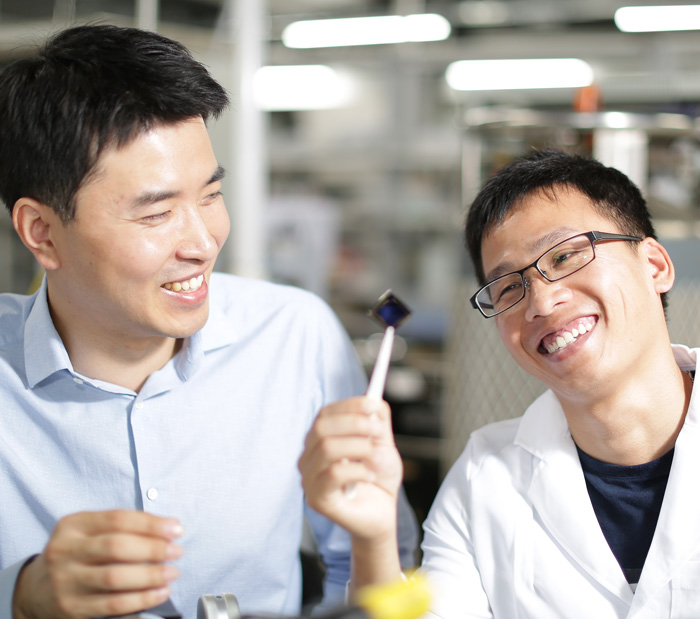
Electronic and Electrical Engineering YU, WOOJONG Prof.
A Memory Device Inspired by the Neuron Connections of the Human Brain
A new memory device inspired by the neuron connections of the human brain have been designed. The research, published in Nature Communications, highlights the device’s highly reliable performance, long retention time, and endurance. Moreover, its stretchability and flexibility make it a promising tool for the next-generation soft electronics attached to clothes or the body. The brain is able to learn and memorize things to a huge number of connections between neurons. The information that a human memorizes is transmitted through synapses from one neuron to the next as an electro-chemical signal. Inspired by these connections, IBS scientists constructed a memory called two-terminal tunnelling random access memory (TRAM), where two electrodes referred to as drain and source, resemble the two communicating neurons of the synapse. TRAM is made up of a stack of one-atom-thick, or a few atom-thick 2D crystal layers: the semiconductor molybdenum disulfide (MoS 2 ) with two electrodes (drain and source), an tunneling insulator of hexagonal boron nitride (h-BN), and a floating gate of graphene layer. In simple terms, memory creates program (logical-0) and erases (logical-1) state by the charging and discharging the graphene floating gate through the h-BN tunneling barrier. By effective charge tunneling through crystalline h-BN layer and storing charges in graphene layer, TRAM demonstrates an ultimately low off-state current of 10 -14 A, leading to ultra high on/off ratio over 10 9 about ~10 3 times higher than other two-terminal memories. Furthermore, the absence of thick, rigid blocking oxides enables high stretchability (>19%) which is useful for soft electronics. This memory device could be useful for the next-generation nueromorphic systems, wearable, and body-attachable electronics in the near future.
- No. 11
- 2018-07-05
- 1679
-

Chemical Engineering PARK, NAM-GYU Prof.
Production of Highly Efficient (20.4%) Perovskite Solar Cells
Perovskite solar cells, which are receiving a great deal of attention due to low cost and high efficiency, are regarded as a promising photovoltaic technology. Perovskite solar cells are easily produced by solution-process but these perovskite thin films are polycrystalline, and grain boundaries that form are thought to be responsible for causing recombination and the trapping of charge carriers. The research team led by Prof. Nam Gyu PARK successfully demonstrated the production of highly efficient and reproducible perovskite solar cells through a grain boundary healing process, resulting in a power conversion efficiency of 20.4% (published in Nature Energy in 2016). The team invented the world’s first long term stable perovskite solar cells, which was published in the journal Scientific Reports (Nature Publishing Group) in August 2012. Prof. PARK’s researches on high efficiency mesoscopic solar cells including perovskite solar cell and dye-sensitized solar cell have been cited 23,526 times, and he received H-index of 66 as of January, 2017 by gaining recognition for the research excellence. For more information, please visit homepage of Prof. PARK’s Research Group at http://ecnl.skku.edu.
- No. 10
- 2018-07-05
- 2595
-
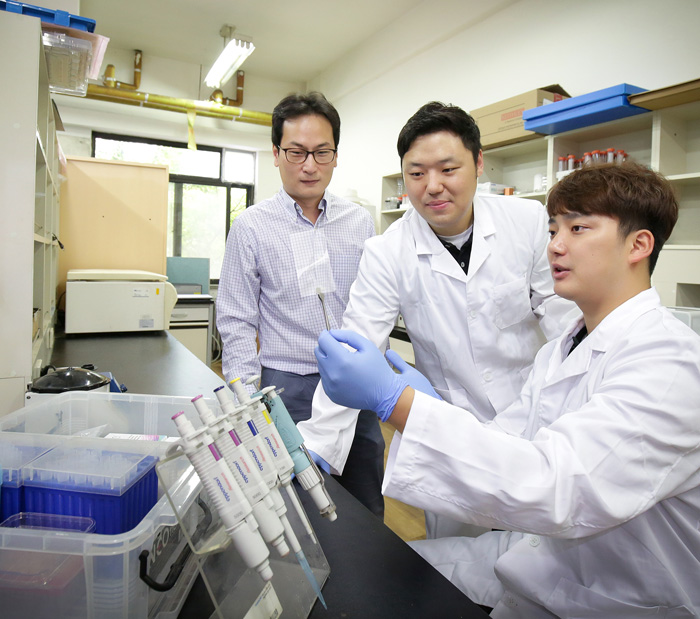
Advanced Materials Science and Engineering LIM, BYUNGKWON Prof.
A New Synthesis of Fabrication of Silver Nanowires Without the Use of Any Organic Stabilizers
Prof. Byung Kwon LIM and two doctorate level students, Hwan Su SIM and Shin Gyu BOK, successfully demonstrated a new synthesis of fabrication of Silver (Ag) Nanowires (NWs) without the use of any organic stabilizers. Ag NWs have attracted great interest owing to their high electrical conductivity, solution processability, and potential for applications in highly conductive transparent or stretchable electrodes. However, organic capping molecules for the production of Ag NWs introduce insulating layers around each nanowire, thus dramatically increasing contact resistance between them and reducing efficiency in electrode applications. A typical procedure for removing organic capping layers from the NWs surface involves many cycles of the precipitation and re-dispersion of NWs in a good solvent for capping molecules, which is tedious and time consuming. The research team resolved the problems by using a little amount of metal salt instead of an organic stabilizer. The heterogeneous nucleation and growth of Ag NWs initially formed AgCl particles, combined with oxidative etching of unwanted silver nanoparticles, resulted in the selective formation of long NWs with an average length of about 40 mm in the absence of a capping or stabilizing effect provided by surfaceadsorbing molecules. These organic-stabilizer-free Ag NWs were directly used for the fabrication of high-performance transparent or stretchable electrodes without a complicated process for the removal of capping molecules from the NW surface. This research was published in the journal Angewandte Chemie under the title of “Organic-Stabilizer-Free Polyol Synthesis of Silver Nanowires for Electrode Applications.”
- No. 9
- 2018-07-05
- 1943
-
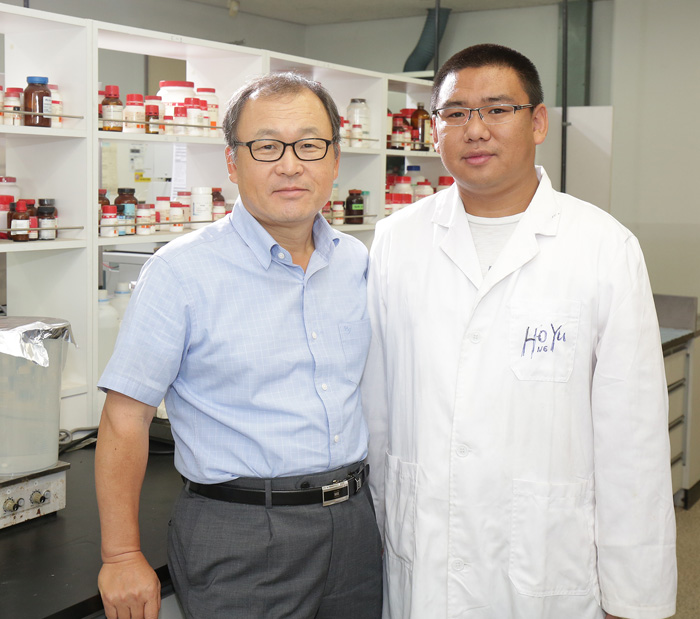
Chemical Engineering LEE, DOOSUNG Prof.
pH-Responsive Biodegradable Polymeric Micelles for MR Imaging in Detection of Cerebral Ischemic Area
Cerebral ischemic area is considered to be an acidic pathological tissue due to the accumulation of lactic acid by the high rate of glycolysis. As a result, this acidic tissue environment provides an opportunity which has been applied for specific targeting diagnosis. Therefore, the design of pH-triggerable targeting imaging probes for the detection of cerebral ischemic area has attracted more attention for the prediction of stroke. A smart nanoparticle was constructed through self-assembly of Fe3O4 nanoparticles and pH-responsive mPEG-b-P(DPA-DE)LG copolymer, which could maintain the stabilized core-shell structure state at physiological pH, whereas Fe3O4 nanoparticles can be released in response to low pH environment. Moreover, this intelligent nanoparticle also showed biocompatibility, T2-weighted contrast-enhancement ability, low toxicity, and long-term stability. A rat bearing cerebral ischemia disease were used to evaluate the effectiveness of Fe3O4-loaded mPEG-b-P(DPA-DE)LG as acidic pH-triggerable targeting MRI probes. The in vivo MRI results confirmed that a gradual change in contrast in the cerebral ischemic area could be visualized by MRI after 1 hour, and maximal signal loss was detected after 24 h post-injection. Therefore, the team believed that Fe3O4-loaded mPEG-b-P(DPA-DE)LG with unique acid-triggered abilities may have more generalized applications in biomedical diagnostic due to their ability to target other acidic pathologic tissues. This research was published in the journal Nanoscale of Royal Society of Chemistry, UK.
- No. 8
- 2018-07-05
- 1779


